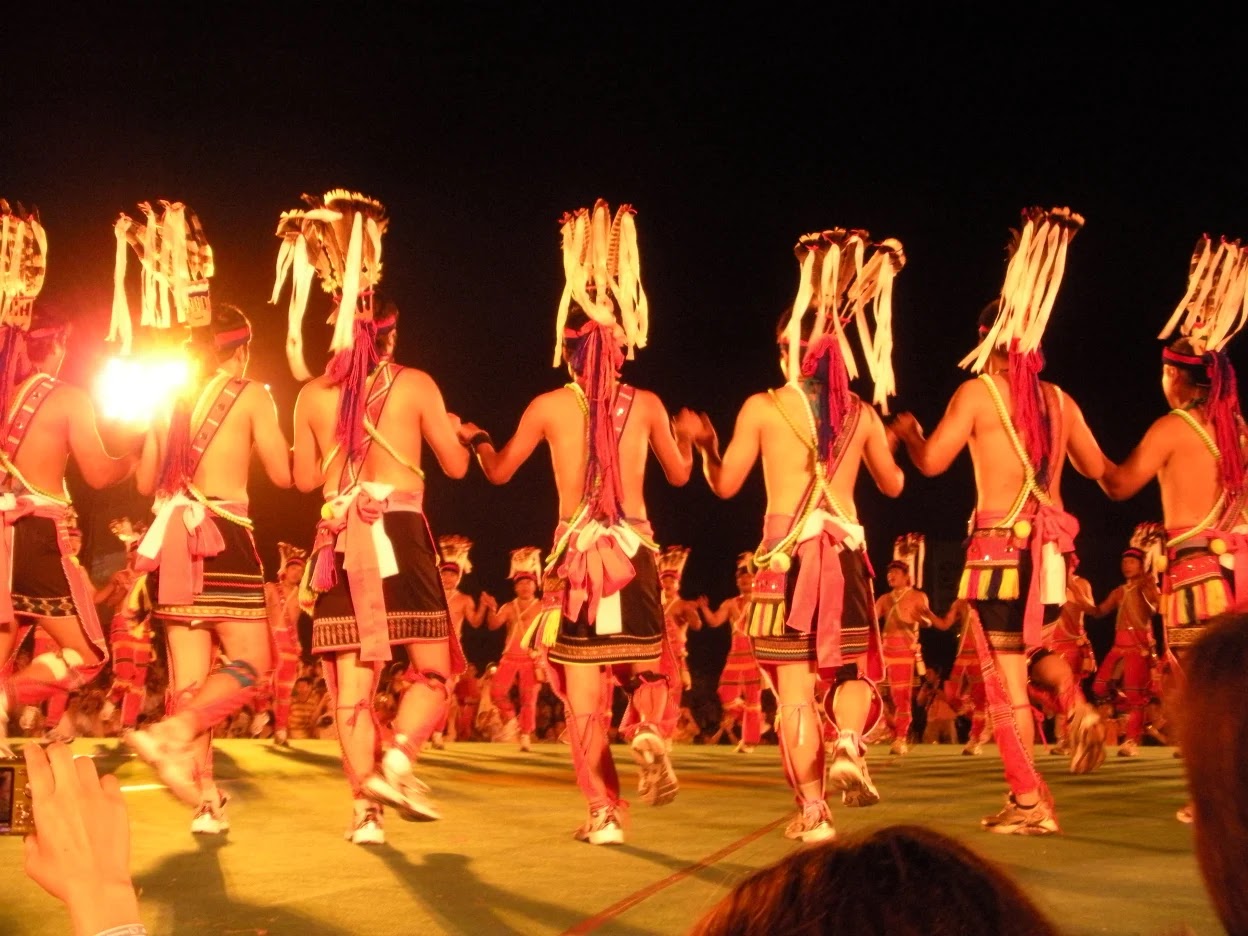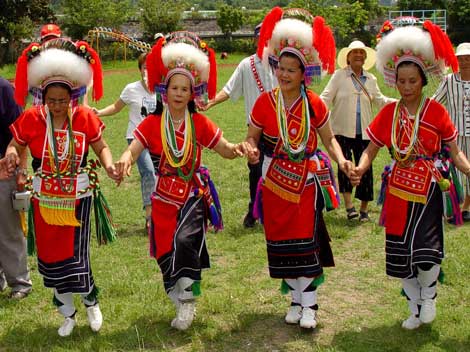MYTHOLOGIES OF THE AMIS TRIBE
The Amis (Amis: Amis, Ami, Pangcah; Chinese: 阿美族; pinyin: Āměizú), also known as the Pangcah, are an indigenous Austronesian ethnic group native to Taiwan. They speak the Amis language (Caciyaw no Pangcah; 阿美族語), an Austronesian language, and are one of the sixteen officially recognized Taiwanese indigenous peoples. The traditional territory of the Amis includes the long, narrow valley between the Central Mountains and the Coastal Mountains (Huadong Valley), the Pacific coastal plain eastern to the Coastal Mountains and the Hengchun Peninsula. In 2014, the Amis numbered 200,604. This was approximately 37.1% of Taiwan’s total indigenous population, making them the largest indigenous group. The Amis are primarily fishermen due to their coastal location. They traditionally had a matrilineal kinship system, by which inheritance and property pass through the maternal line, and children are considered born to the mother’s people.Traditional Amis villages were relatively large for Taiwanese indigenous communities, typically holding between 500 and 1,000 people. In today’s Taiwan, the Amis also comprise the majority of “urban indigenous people” and have developed many urban communities all around the island. In recent decades, Amis have also married exogamously to the Han as well as other indigenous peoples.
Amis people call themselves “Pangcah”, which means “people” and “kinsmen”. Most Amis people in Taitung settled north of the Puyuma who called these Pangcah “Amis”, meaning “northerners” or “people in the north”. After the adoption and dissemination of the academic circle, “Amis” has replaced the term “Pangcah” for this ethnic group. The origin of Amis (Pangcah) includes two mythological systems: the “myth of origin” and the “legend of distribution”. According to northern Amis, the Pangcah came from the descendants of deities; while southern Amis believe that their ancestor was born from stone. The Amis is the largest indigenous ethnic group in Taiwan mainly distributed in the east of the Central Mountain Range and the plains area south of the Liwu River, covering two eastern Taiwan counties: Hualien and Taitung, and the Hengchun Peninsula in Pingtung County. With a widespread distribution, Amis mainly fall into three main blocks by region and by custom: northern Amis (also called Nanshi Amis (Amisay a Pangcah)), central Amis (including Amis settling in the Xiuguluan River basin (Siwkolan Amis) and in the coastal area (Pasawalian Pangcah)), and southern Amis (including Amis settling in Taitung: Farangaw Amis and on the Hengchun Peninsula (Palidaw Amis)). The earliest record regarding Amis contact with outsiders can be traced back to some four hundred years ago with a Dutch gold mine exploration team. However, the proactive and close outsider contact of the Amis did not come until the last 20 years of the Qing dynasty.
Taiwanese indigenous peoples (formerly Taiwanese aborigines), also known as Native Taiwanese, Formosan peoples, Austronesian Taiwanese, Yuanzhumin or Gaoshan people, are the indigenous peoples of Taiwan, with the nationally recognized subgroups numbering about 569,000 or 2.38% of the island‘s population. This total is increased to more than 800,000 if the indigenous peoples of the plains in Taiwan are included, pending future official recognition. When including those of mixed ancestry, such a number is possibly more than a million. Academic research suggests that their ancestors have been living on Taiwan for approximately 6,500 years. A wide body of evidence suggests Taiwan’s indigenous peoples maintained regular trade networks with regional cultures before the Han Chinese colonists began settling on the island from the 17th century. Taiwanese indigenous peoples are Austronesians, with linguistic and cultural ties to other Austronesian peoples in the region. Taiwan is also the origin and linguistic homeland of the oceanic Austronesian expansion whose descendant groups today include the majority of the ethnic groups throughout many parts of East and Southeast Asia as well as Oceania such as Brunei, East Timor, Indonesia, Malaysia, Madagascar, Philippines, Micronesia, Island Melanesia and Polynesia. The Chams and Utsul of contemporary central and southern Vietnam and Hainan respectively are also a part of the Austronesian family.

Amis have found a way to keep alive their ancient wisdom by providing visitors with a crash course in tribal rituals and lifestyles. High above our archery debacle, a decorated wooden platform on stilts housed a large group of Amis men and women, plus a handful of dogs. A shaggy, overgrown bamboo forest surrounded the homestead, and after we emptied our quivers, a couple of the tribesmen took us for a hike through the native plants to show us their medicinal properties—how to find clean drinking water in the bottom of a bamboo stalk, and how to chew a particular blade of grass into a coagulant paste. The Amis work hard—dividing up the many daily tasks and chores, and running a small handicrafts’ shop on the property—but their downtime is free and easy, and despite the language barrier, we enjoy each other’s company sitting around on the porch, playing with the dogs, noodling on the guitar and singing, and watching the men compare ceremonial knives and laughing into the wide open skies.

The traditional Amis people are a matriarchal society. They really value clever dancing, dexterous and joyful singing, and outgoing, take-charge, optimistic people. Amis people tend to be quite tall. The northern Amis people are distributed between Fenglin and Hualien City, through Shoufeng and Ji’an in Hualien County. The central Amis people are located in Fengbin, Dagang, and Ruisui. The southern Amis live in the vicinity of the Taidong Plain. The Amis located in Taidong City, Malan, and Dulan are called the Taidong Amis.

According to many visitors to Taiwan, the magnificent East coast stretching from Hualien to Taitung County is arguably the most beautiful area of Taiwan. It is often compared to the scenic coastlines in Hawai’i, California or New Zealand. The scenery of Taroko Gorge, as well as the towering cliffsides met abruptly by the deep blue Pacific Ocean leave their indelible impressions on visitors. However, the distinctive cultures of the locals are what gives visitors a rich, colorful experience they will always remember. This idyllic scene is interrupted by drum beats and a powerful chorus of villagers. Men, women and children of all ages participate, gathering hand-in-hand in large circles. Thousands wearing beautiful tribal costumes dance and sing in the native language of the Amis tribe. Under the hot, July sun, they give thanks to the plentiful harvest of millet. They also bless the abundant catch of the local fishermen. Families offer some of the fattest pigs, to sacrifice for the days of feasting. The locals enjoy continuous celebration, and it’s celebration with purpose. The village leaders organize festival activities that promote respect, gratitude and unity. This is an opportunity for the children of the village to put away their iPads and smart phones to focus on messages from their elders and their parents. It is a time to immerse themselves in their Indigenous culture experiences, and to express their own modern flavor during their performances. Younger generations learn many of the traditional songs and dances from their elders, and they create their own style of performances based on what they learn from the elders and from their modern pop influences. The result is an energetic mixture of new and old culture that delight the locals and the tourists.
In China, the Amis were considered too small by the government to be recognized as an official minority group. Along with the Bunun and Paiwan tribes, they were grouped together under the official banner of Gaoshan, a generic Chinese name which simply means “high mountains”. The Ami believe they are descended from the god Abokurayan and from the goddess Taribrayan who produced so many children that the Ami had to move from Orchid Island to the Taiwan mainland. The Ami, who “seem to be composed of several more or less unrelated ethnic elements,” say their ancestors came from an overseas island called Sanasai or Vasai. Some scholars have speculated these islands are today’s Caroline Islands in the Pacific Ocean. Small pockets of Ami migrated across the Taiwan Strait to China at least a century ago. Between 1946 and 1949, about 100 Ami men were forcibly enlisted in the Kuomintang forces during the civil war in China. When the KMT lost to the Communists, most stayed in Fujian and formed Ami communities.
Most people in Taiwan speak more than one language, but often English isn’t one of them. The official language is Mandarin Chinese, and it’s more or less the same as the official language of the People’s Republic of China. That said, each part of China has a regional accent, plus different expressions, so Mandarin speakers are usually able to distinguish mainlanders from Taiwanese by the way they talk. With varying degrees of fluency, most of Taiwan’s people speak what they call Taiwanese, but what language scientists call Holo, Hokkienese or Minnanhua. Between the 1950s and the 1980s, Taiwan’s education system stressed Mandarin at the expense of Taiwanese; students who spoke Taiwanese in the classroom were punished. Realising that Mandarin proficiency is needed for any decent career, many parents decided to speak Mandarin rather than Taiwanese to their children. As a result, while almost everyone born in Taiwan 65 or more years ago speaks fluent Taiwanese, many of those born in last few decades don’t speak the language well. Ability to speak Taiwanese is no longer a clear indicator whether a person is Hoklo or not. For similar reasons, few young people are proficient in Hakka, even if both parents are Hakka. That said, young people in the cities are far more likely to speak English than older people and country folk. Some elderly Taiwanese can speak Japanese because they attended school during the Japanese occupation.




























Comments
Post a Comment